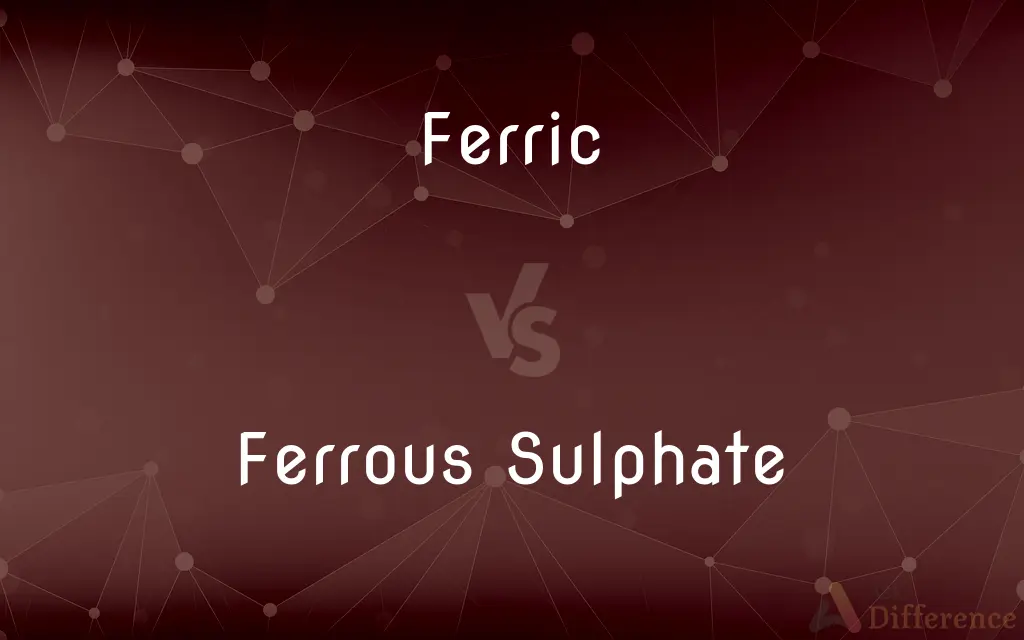Ferric vs. Ferrous Sulphate — What's the Difference?
By Tayyaba Rehman — Published on November 15, 2023
Ferric refers to iron with a +3 oxidation state, forming compounds like ferric sulphate (Fe2(SO4)3). Ferrous sulphate, FeSO4, involves iron in a +2 oxidation state, exhibiting different properties and uses.

Difference Between Ferric and Ferrous Sulphate
Table of Contents
ADVERTISEMENT
Key Differences
Ferric, in the context of ferric sulphate, refers to the iron compound where iron is present in a +3 oxidation state. This state signifies that the iron has lost three electrons during the formation of the compound, resulting in a characteristic rusty brown color. On the other hand, ferrous sulphate involves iron in a +2 oxidation state, suggesting it has parted with two electrons and often appears as a greenish or bluish-green compound. Both play distinct roles in diverse applications due to these fundamental differences.
Moreover, ferric compounds like ferric sulphate, generally exhibit more covalent character, resulting in lower solubility in water as compared to ferrous sulphate. Ferrous sulphate dissolves well, yielding a high concentration of iron ions, which makes it particularly effective in certain medical and agricultural applications. It is important to note that the electron loss in these iron compounds influences not only their physical appearance but also their chemical behavior, thereby dictating their functional applications in various industries.
In industrial wastewater treatment, ferric sulphate is often applied due to its capability to precipitate phosphates and other contaminants effectively. Contrastingly, ferrous sulphate finds its utilization prominently in the reduction of chromate in cement. The dissimilarities in their chemical behavior, particularly in their interaction with other compounds, are pivotal in determining their suitability and effectiveness in different chemical processes.
The difference in their oxidation states also renders ferric and ferrous compounds to engage differently in redox reactions. Ferric, with its +3 oxidation state, is an oxidizing agent, while ferrous sulphate can act as a reducing agent. This significant distinction influences their utility in various chemical reactions and processes, with ferric being utilized in processes where oxidation is crucial, and ferrous sulphate being employed where reduction is desired.
Furthermore, ferric compounds tend to be less reactive with ligands as opposed to their ferrous counterparts. Ferrous sulphate, being more prone to ligand exchange and coordination reactions, finds extensive use in various chemical syntheses. Thus, although ferric and ferrous sulphate both originate from iron, their varying oxidation states crucially delineate their characteristics and applications across different domains, from medical treatments to manufacturing and environmental processes.
ADVERTISEMENT
Comparison Chart
Oxidation State
+3
+2
Color
Rusty brown or yellow
Greenish or bluish-green
Solubility
Generally less soluble
Highly soluble
Redox Behavior
Acts as an oxidizing agent
Can act as a reducing agent
Reactivity with Ligands
Generally less reactive
More reactive and forms complexes
Compare with Definitions
Ferric
Ferric denotes iron compounds with an oxidation state of +3.
Ferric ions can often impart a yellow color to solutions.
Ferrous Sulphate
Ferrous sulphate readily engages in coordination chemistry.
Ferrous sulphate can coordinate with various ligands, forming complex structures in solutions.
Ferric
Ferric compounds typically exhibit less solubility in water.
Ferric hydroxide forms a precipitate when mixed with sodium hydroxide.
Ferrous Sulphate
Ferrous sulphate is notably soluble in water.
When ferrous sulphate is dissolved in water, it dissociates into iron (II) and sulphate ions.
Ferric
Ferric compounds usually demonstrate covalent character.
Ferric chloride shares electrons covalently within its structure.
Ferrous Sulphate
Ferrous sulphate can act as a reducing agent.
Ferrous sulphate is utilized to reduce the yellow chromate ions to green chromic ions in cement.
Ferric
Ferric materials can act as oxidizing agents.
Ferric chloride is used to oxidize alkenes in organic synthesis.
Ferrous Sulphate
Ferrous sulphate has a characteristic greenish or bluish-green color.
The pale green color of ferrous sulphate crystals is recognizable in laboratories.
Ferric
Relating to or containing iron, especially with valence 3 or a valence higher than in a corresponding ferrous compound.
Ferrous Sulphate
Ferrous sulphate consists of iron in a +2 oxidation state.
Ferrous sulphate is often used to treat iron-deficiency anemia.
Ferric
Pertaining to, derived from, or containing iron.
Ferric
(chemistry) Of compounds of iron in which it has a valence or oxidation number of 3
Ferric
Pertaining to, derived from, or containing iron. Specifically (Chem.), denoting those compounds in which iron has a higher valence than in the ferrous compounds; as, ferric oxide; ferric acid.
Ferric
Of or relating to or containing iron
Ferric
Ferric compounds often engage minimally in ligand exchange.
Ferric ions tend to hold onto water molecules in solution, showing limited ligand exchange.
Common Curiosities
Why is Ferric Sulphate less soluble in water than Ferrous Sulphate?
Ferric compounds typically have more covalent character and form less ionic solutions, which generally results in lower solubility compared to Ferrous Sulphate.
In which industries are Ferric and Ferrous Sulphate commonly used?
Both are used across various industries like water treatment, agriculture, and medicine, albeit in different processes due to their distinct chemical properties.
What is Ferric?
Ferric refers to iron in a +3 oxidation state, forming compounds like ferric sulphate, and usually presenting a rusty brown or yellow color.
How do Ferric and Ferrous Sulphate differ in redox reactions?
Ferric acts as an oxidizing agent, while Ferrous Sulphate can function as a reducing agent in redox reactions.
What is Ferrous Sulphate?
Ferrous Sulphate (FeSO4) is an iron compound where the iron is in a +2 oxidation state, often recognized by its greenish or bluish-green hue.
Why does Ferrous Sulphate often appear green?
The greenish hue of Ferrous Sulphate is attributed to its specific electron configurations and the way it absorbs and reflects light.
Can Ferric and Ferrous Sulphate be used interchangeably in reactions?
No, due to different oxidation states and chemical behaviors, they have distinct applications and are not generally interchangeable.
Are Ferric and Ferrous Sulphate safe for human consumption?
Both are used in specific applications related to human health but must be utilized under appropriate guidelines and dosages.
What is the significance of their different oxidation states?
The different oxidation states (Ferric +3, Ferrous +2) impact their electron configurations, influencing their chemical behaviors, reactivities, and applications.
Which one is used more in wastewater treatment?
Ferric Sulphate is often favored in wastewater treatment due to its effectiveness in precipitating phosphates.
What are the safety considerations when handling Ferric and Ferrous Sulphate?
Both should be handled with care, avoiding inhalation or ingestion, and using protective wear to prevent skin and eye contact.
Which of Ferric or Ferrous Sulphate is typically used in anemia treatment?
Ferrous Sulphate is commonly used in treating iron-deficiency anemia due to its higher solubility and bioavailability.
Can Ferric be converted to Ferrous, and vice versa?
Yes, through redox reactions, Ferric can be reduced to Ferrous, and Ferrous can be oxidized to Ferric, under suitable conditions.
Can Ferric and Ferrous Sulphate be stored under similar conditions?
Both should be stored securely, but considerations like moisture control might differ due to their varied physical and chemical properties.
Are both Ferric and Ferrous Sulphate naturally occurring?
Yes, both can be found in nature, often in minerals, albeit in different forms and abundances.
Share Your Discovery

Previous Comparison
Server in Restaurant vs. Host in Restaurant
Next Comparison
Prototype vs. OriginalAuthor Spotlight
Written by
Tayyaba RehmanTayyaba Rehman is a distinguished writer, currently serving as a primary contributor to askdifference.com. As a researcher in semantics and etymology, Tayyaba's passion for the complexity of languages and their distinctions has found a perfect home on the platform. Tayyaba delves into the intricacies of language, distinguishing between commonly confused words and phrases, thereby providing clarity for readers worldwide.













































